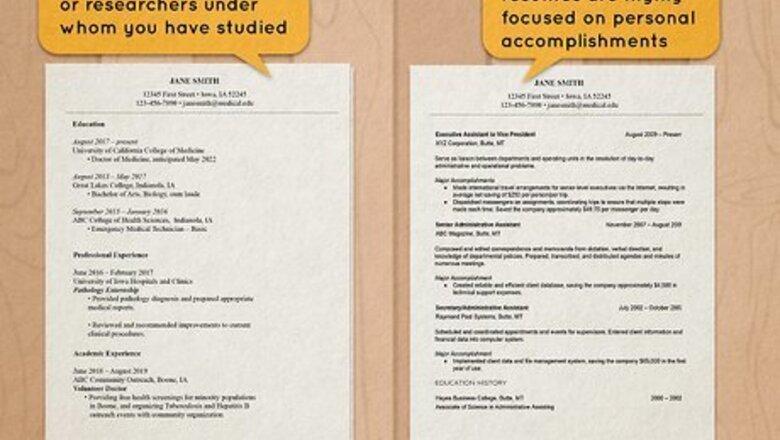
views
Understand the difference between a resume and a CV.
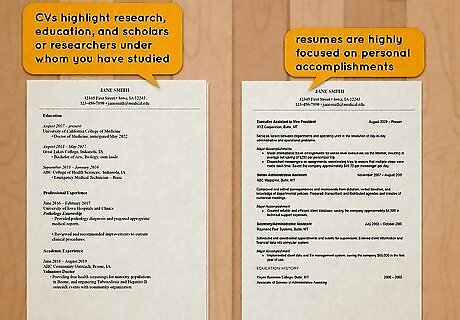
There are a few key differences that make writing a CV easier. Resumes are typically one page in length, which can make it hard to compact everything on the page. A CV can be as long as you want. In addition, you have a bit of freedom when it comes to your headers, as well as what you include. Use a template to make this easier. You can find CV templates online or through your word processing program. Personalize it to fit you, but ensure that headings, font type, and size remain consistent throughout your CV. Resumes are highly focused on personal accomplishments. CVs highlight research, education, and scholars or researchers under whom you have studied.
Construct your headers.
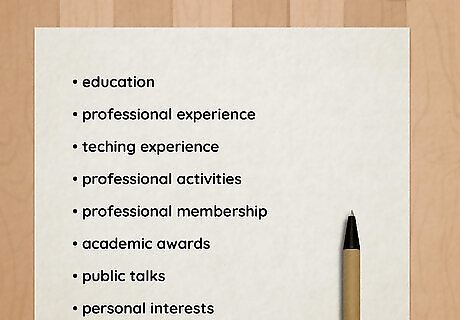
Divide all other relevant information into specific categories. You have to include education and work experience. The rest of it depends on you! The way you organize your CV for medical school is determined by how much and what type of information you have to share. Categorize it so that your CV is easy to follow. If you do not have information for a specific category, leave that section out. CVs can have several specific categories, including training, teaching, workshops, seminars, research, lectures, conferences, publications, degrees, continuing education, scholarships, fellowships, volunteer experience, appointments, and more. You can add or drop certain headers as needed. So long as you cover your education and work experience, the rest is up to you.
Keep the formant clean and consistent.
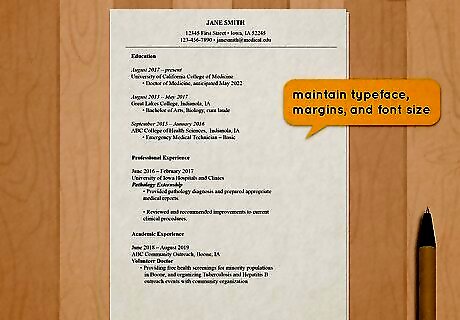
You can stylize a resume, but keep the CV crisp and clear. There are several ways you can format a CV when it comes to the typeface, margins, and font size, but boring is probably better than snazzy here. The important thing is that you keep it consistent. Don’t swap fonts halfway through or anything like that. Use present tense when talking about things you’re currently doing, and past tense when describing previous work. Number the pages. Help reviewers refer to certain pages when they are discussing your CV and application to medical school. Number long lists or use bullet points. This helps others see how much you have accomplished at a quick glance. It also helps when you try to refer to a specific role or achievement.
Research the medical school you’re applying to.

Emphasizing the aspects of your CV that align with the school’s mission is key. You can’t do that though if you don’t understand the school’s values and programs. Learn about the specific programs they offer. Read about the research their medical professors are currently undertaking. Find relevant connections between your interests and theirs. For example, if a school seems really invested in their Alzheimer’s research, include any research you’ve done on Alzheimer’s disease. If they love playing up their community health initiatives, volunteer at a local clinic and include it on your CV. The earlier you can do this, the better. If you get started a year or two before you plan on applying, you’ll have time to look for internships and research projects that directly relate to the school’s mission.
Read through their CV requirements, if they have any.

Most medical schools explain what they want in a CV. Look through the medical school’s website and find where they mention the CV when describing the application process. There’s typically a description of what the school wants to see in an applicant’s CV. Read this section thoroughly and follow their recommendations. For example, they might tell you to leave off any work you did as an undergraduate student, or request a specific section addressing your coursework.
Put your personal info at the top.
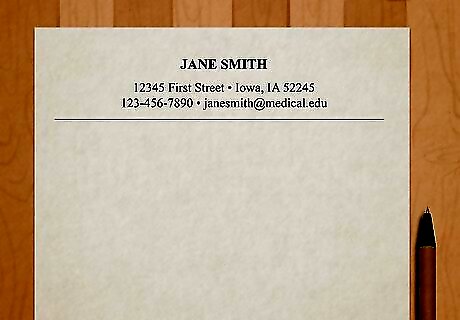
List your name as it will appear on your application. Include your phone number, address, and a professional email address. Use this as your header. The rest of your CV should be flush left on the page, but you can center your personal at the top. It seems like a little thing, but many people forget to do this! Do not do this if you are explicitly told not to in the application. Some medical schools use “blind” applications where your name doesn’t appear to prevent biases from influencing the reader.
List your education.

This is especially important since you are applying to graduate school. Highlight the college or university you attended. Include the degree you will graduate with, if you will graduate with honors, and if you have any concentrations or special interests within the medical field. For each entry, put the years you attended on the right side of the page. Separate any residencies you’ve completed. List the information in reverse chronological order so that your most recently attended school appears first.
Include relevant work experience.

Any experience you have in a medical setting counts here. Since you are applying to medical school, any work experience you have will place you at the front of the crowd of applicants. If you have interned at a doctor's office, served as a research assistant, volunteered at a local health clinic, or assisted with a health class, list that on your CV. Split them into specific categories. If you do not have any relevant work experience, move this section down so that you prioritize your academic experience. Use reverse chronological order so that your recent work experience appears first.
List academic appointments if you’ve had any.
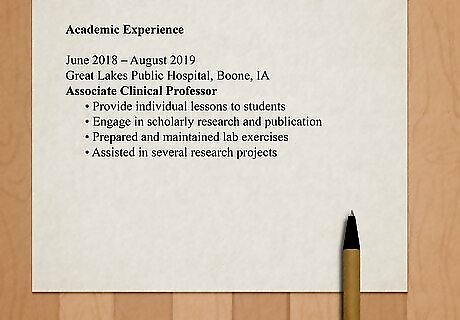
If you’ve taught anything, list that underneath your professional experience. This is unlikely to apply to you if you’re applying to your first medical school after undergrad, but include any relevant experience you have working in academia. List course you’ve taught, teaching assistant positions you’ve held, or tutoring experience if applicable. It’s okay if you weren’t paid. Volunteering as a tutor, for example, is a totally valid line item. However, if you do this, don’t make the header “academic appointments.” Use “academic experience” instead. Continue to use reverse chronological order with academic appointments.
Describe your professional memberships, honors, and awards.
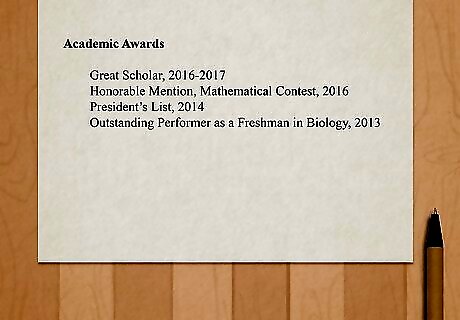
Mention any organizational relationships or accomplishments. Use your own judgement here to determine whether an award or membership is worth mentioning or not. If you’re a part of any student organizations that focus on medicine, include it. If you got an award for creative writing, it’s probably not relevant, though. Include academic awards! Graduating as valedictorian, or magna cum laude is impressive. Again, use reverse chronological order.
Craft a section for publications.
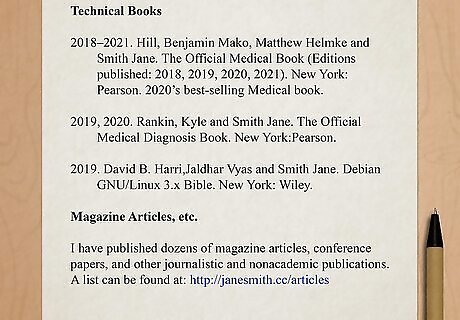
Include the title, publication, and date for each work. Don’t include anything that you wouldn’t be willing to share. If you have a thesis project, you can include that here as well. Use regular chronological order for this section; this way, the reader can see the way your work builds on itself. Research papers and projects, dissertations, theses, and publications all demonstrate the specific medical field you are interested in. They also reveal the depth of research you have already done. If you don’t have any publications and you plan on applying to medical school in the future, start submitting your work now! Get as many papers published as you possibly can. A lot of students who apply don’t have a lot of published work, so this is a big way to stand out from the crowd.
Note collaborative work and presentations near the end.
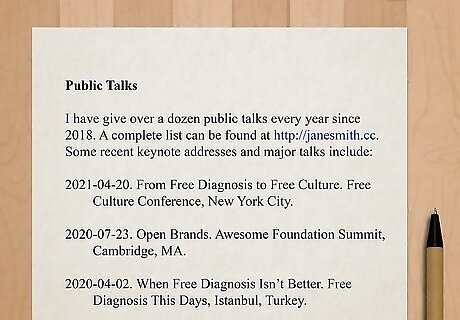
This includes studies you’ve helped with or forums you’ve spoken at. Abstracts, editing credits, presentations, and speeches all go towards the end. This stuff speaks to your collaborative spirit, and it’s good to include these things as it demonstrates your ability to engage in the kind of academic work doctors are typically expected to do. It’s okay if you don’t have anything to put in this section; just leave it out if you have to. This is a “nice to have” not a “need to have” section. Lectures, seminars, conference messages, or any type of public speech shows that you are recognized as a knowledgeable individual about that specific topic.
Include a section for personal interests.

This isn’t mandatory, but it’s a good way to stand out from the crowd! Medical schools can find students with the academic chops, no problem. There’s no shortage of students with good GPAs out there looking to become doctors. Showcasing your personality is a great way to make yourself stand out. List any novel interests in this section at the end. Sports, creative endeavors, and talents are all worth mentioning. This line item might look like this: “Billiards, poetry, competitive card games, computer building, reading, religious studies.”


















Comments
0 comment